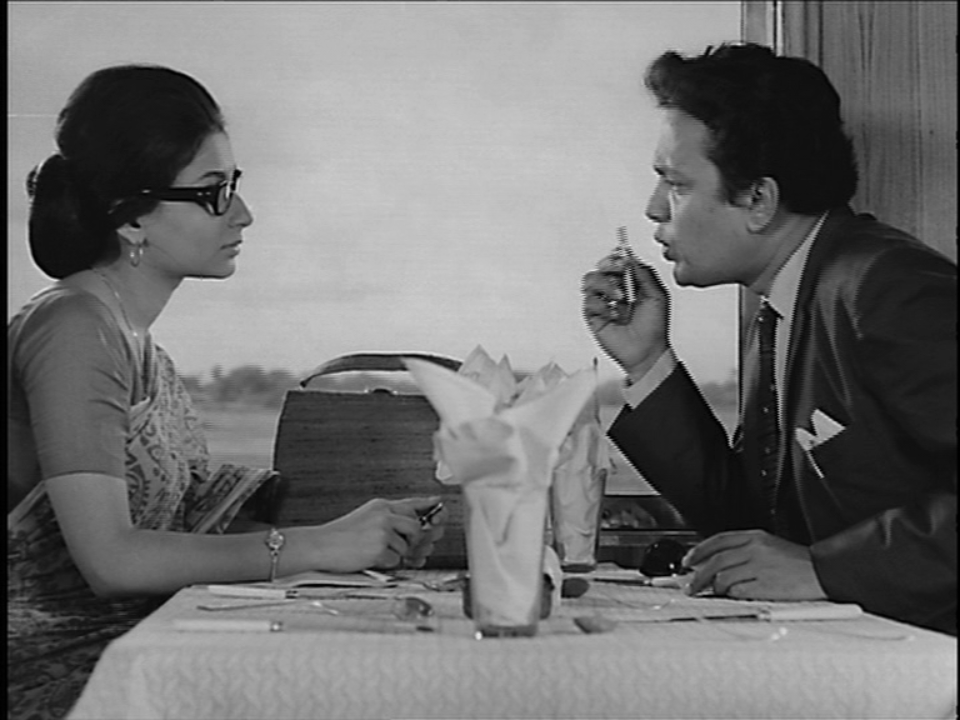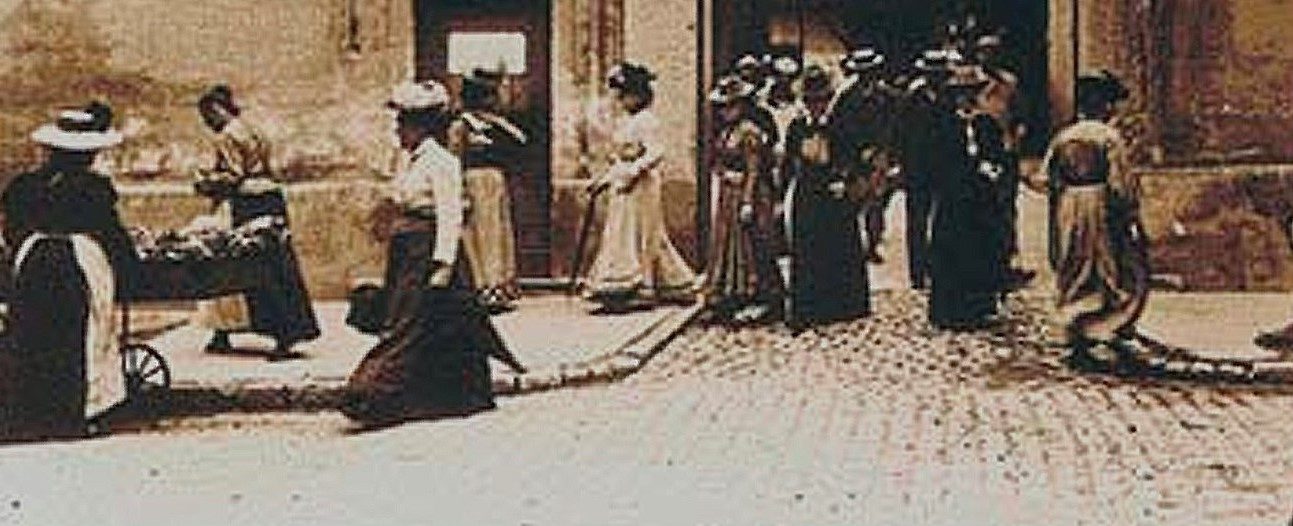India, 1966
Directed by Satyajit Ray
With Uttam Kumar (Arindam Mukherjee), Sharmila Tagore (Aditi), Ranjit Sen (Haren Bose), Bharati Devi (Manorama Bose), Lali Chowdhury (Bulbul Bose), Kamu Mukherjee (Pritish Sarkar), Susmita Mukherjee (Molly Sarkar), Nirmal Gosh (Jyoti), Somen Bose (Sankar), Sumita Sanyal (Promila Chatterjee), Hiralal (Kamal Misra), Premangshu Bose (Biresh)

The titles roll over a geometric pattern akin to a grid eventually blurring into the black mass of the hair at the back of a head. The face is not immediately shot; actually the camera shots in closeups parts of the body as the character gets dressed, paces his airy, modern bedroom, starts to talk with another man, who is fully shot while getting rather bullied, his personal assistant and old pal Jyoti. It is thus through a scattered, fragmentary, confused flow of images, ushered in by a forbidding, stern pattern, that the film introduces the lead character, Bengali movie actor and matinee idol Arindam Mukherjee, a remarkably blunt but kinetic vision which at the same time is distinctly unromantic and unconventional for such a character.
The man himself does not come across as a pleasant and nice fellow: his snappy reactions, his irony and hectoring, his brash attitudes suggest a deeply conceited and cavalier personality. And indeed, he does not make the headlines in that morning’s papers not just because he is to leave Kolkata to get in Delhi an award but also because he was involved in a brawl with another man, clearly under the influence. He shrugs off the offer of a new contract, to the dismay of an associate, and rushed to get on the train, fancying his trip could bring some relief.
The film then widens what looked like a character study: if Arindam Mukherjee is still the main focus, if only because his presence stirs so much interest, other characters get scrutinized. There are first, obviously, the folks who are in the same compartment: a wealthy, leading businessman, Haren Bose, his wife Manorama Bose, and their sick daughter Bulbul; then there is another white collar worker, an advertising executive hoping to convince Haren Bose to sign a contract with his young company, Pritish Sarkar, who is traveling with his wife Molly; a young, spirited couple who accompanies a quieter, and lonely, young woman, Aditi, excited by Aditi’s new professional achievement, the editing of a women’s magazine; also feature a grumpy and arch-conservative old man, and the ever-smiling, ever-busy conductor.
Some scenes provide comic relief, but others point to the grim difficulties of being successful and satisfied, worries that seem so remote to the star’s life. Haren Bose proves to be more interested in boasting talks, a chess game, and especially the diffident and charming Molly Sarkar than what Pritish Sarkar tries to tell him. Another case of vanity, arrogance, and feeling of entitlement, far less glamorous and far more brutal than the actor, Haren Bose illustrates a paternalistic view of the world quick to consider women as sexual objects or family property. At the other end of the success spectrum, Pritish Sarkar is a pathetic social climber ready to ask his wife the unacceptable only to get a footing in a business empire far too big for his skills and size; his hopeless clumsiness at first amuses, then dismays, and eventually looks poignant, especially when he is forced to realize the gap between his expectations for his wife and her own expectations for life.
Pritish Sarkar is not the only operator awkwardly attempting to grab an opportunity as the train speeds to the capital: Aditi, encouraged by her friends, decides to interview for her publication Arindam Mukherjee. But the star objects to any serious discussion that could delve deep into his life and motives. Part of the plot is built between the relation both struggle to have, reflecting first the diffidence and weak position of the young woman, despite her intelligence, and then how her ability to listen and analyze get so badly needed.
If she becomes a confidant against all odds, it is because she is the rare case of an Indian who is not thrilled and getting dizzy, if not crazy, by the presence of a movie actor, when the character is not dreaming of being part of the business, as it is the case of Molly Sarkar. Scenes emphasize what a fame and a prestige film success can bring, but at the same time the perfunctory, even sometimes cynical, way the actor deals with the fawning of the ladies and the crowds, or the contempt of the cantankerous old intellectual and the snobbish Haren Bose, points to the sheer vanity and complete futility of the stardom and fandom. Arindam Mukherjee’s behavior, which is in keeping with the beginning’s unsympathetic portrayal, and the words that he exchanges self-deprecatingly with others about the state of Indian cinema sound like a scathing criticism of the national cinema. Director Satyajit Ray clearly denounces the mediocrity of a production system, a star system, and an audience, unwilling to pursue high-minded goals for the seventh art.
But his train trip turns to force him deeper in a searing and disturbing examination of his career and life. Twice he has nightmares even as he was hoping for a nice sleep, the first a horrific vision blending money and death, the second a grotesque remembrance of a testy conversation he had with a would-be actress Promila Chatterjee. Talking with Aditi, who uses his need to confess write stealthily an article, suddenly feels like the opportunity to clear up his mind. He feels forced to examine his past, in particular the way he fell out with a man he respected a lot, a mentor who turned him into a stage actor, but got incensed when Arindam Mukherjee started to negotiate with a studio, Sankar, the disastrous collaboration with an old movie star who later became a drunkard and a nonentity, Kamal Misra, or how he failed to help a longtime pal, a political activist who has hoped the actor could feel concerned by the struggle of the workers, Biresh.
The talk, as noted, transforms the dynamics between Aditi and Arindam Mukherjee, and the positions and movements of the camera gracefully reflect it. The story keeps widening, becoming the chronicle of an intimacy that cannot leave the young woman unconcerned and suggests the famous bachelor also needs the kind of understanding and the special bond love can bring – the final shots on the platform of the Delhi railway station underline the idea. But it remains the study of an archetypal success in the seventh art, the Indian way, and keeps exploring that essential gap between what cinema could be and should be as an art and what popularity and commerce have made it.
Arindam Mukherjee is basically gripped by a far deeper existential crisis than he carelessly thought, and teetering on the edge of a precipice, or rather nearly tripping over the rails. He survives – that is, he dares not to kill himself. And he proves eager to keep in touch with Aditi, who proves to be such a strong support – and symbolically tears up her article: there are things that cannot be told in public, but not for the reasons the actor previously stated. The carefully crafted public persona cannot be tarnished, but constantly burnished, that was his the point, and the system’s flaw. But at the end of this strange trip, the truth is that what is tearing the actor apart is something that only he can face and tame. It remains to be seen if he is up to the task – it is not impossible, but it is hard to be sure.
The film has started by shattering and slamming as bluntly and vividly as possible the image and the nature of the matinee idol, a bitter criticism of the way India enjoys and creates films. But this deconstruction turns out to be far more perceptive and compassionate. It digs relentlessly, harshly deep into the conscience of the titular character, exposing flaws justifying the underlying criticism but also revealing a more complex and moving picture, of a man still coming to terms with the easy option he signed up to years earlier, under the influence of his pal Jyoti, deeply aware of how failure can easily come in the way, ruining an insecure and futile career. The cinema he embodies is an illusion, and the most tragic part is that people crave for this illusion, even view it as an opportunity, as they struggle in their lives.
But entertainment cannot truly paper over the cracks, frustrations, disappointments so rife in the Indian society, including in the emerging middle class, that the trip has hinted to. It is facing truth and articulating grievances that eventually helps and changes Arindam Mukherjee – and perhaps a better role for cinema should be to pay attention to the real feelings of people, to observe and show their personal experiences, to build a space for sincere dialogue and genuine sympathy, to turn a film into an enlightening narrative attuned to the many aspects of the individual, good as well as bad. And this is precisely what “Nayak” boils to, and why it ends with a relative optimism about Arindam Mukherjee, which has nothing to do with the tacky, rosy endings of the usual Indian melodrama, but a lot with an empathetic and analytic approach.

